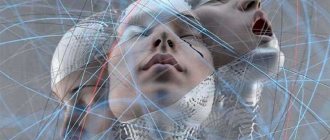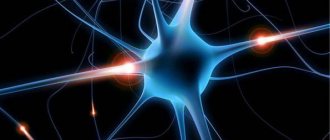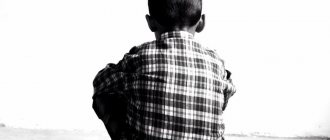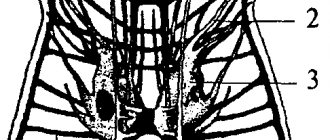Disorders of the emotional-volitional sphere in children. interesting facts on the topic
Emotional-volitional disorders can manifest themselves in different ways:1. Increased excitability. Children of this type are restless, fussy, irritable, and prone to unmotivated aggression. They are characterized by sudden mood swings: they are either overly cheerful, or suddenly begin to be capricious, seem tired and irritable.
Affective arousal can occur even under the influence of ordinary tactile, visual and auditory stimuli, especially intensifying in an environment that is unusual for the child.
2. Passivity, lack of initiative, excessive shyness. Any situation of choice puts them at a dead end. Their actions are characterized by lethargy and slowness. Such children have great difficulty adapting to new conditions and have difficulty making contact with strangers. This syndrome, as well as a joyful, elated mood with a decrease in criticism (euphoria), is observed with lesions of the frontal lobes of the brain.
Phobic syndrome, or fear syndrome, is characteristic of many children with cerebral palsy. Increased impressionability, combined with emotional excitability and affective inertia, creates a favorable background for the emergence of fear neurosis. Fear can arise even under the influence of minor psychogenic factors - an unfamiliar situation, short-term separation from loved ones, the appearance of new faces and even new toys, loud sounds, etc. In some children it manifests itself as motor agitation, screaming, in others - physical inactivity, general lethargy and in both cases it is accompanied by pronounced vegetative-vascular reactions - paleness or redness of the skin, hyperhidrosis, increased heart rate and respiration, sometimes chills, and increased temperature. When fear arises in a child, salivation and motor disturbances (spasticity, hyperkinesis, ataxia) increase. Psychogenically caused obsessive phobias in the form of fear of loneliness, heights, and movement are possible; in adolescence - fear of illness and death.
Fears that arise spontaneously, without connection with any psychogenic factors, are called neurosis-like; they are caused by organic brain damage. These include undifferentiated night terrors, which appear sporadically during sleep and are accompanied by screaming, crying, general agitation, and autonomic disorders. They are typical for children with hypertensive-hydrocephalic syndrome and often occur against the background of hyperthermia. If fears appear suddenly, against the background of somatic well-being, at a certain time of night sleep, at regular intervals, and are accompanied by motor automatisms, they should be distinguished from paroxysms of epileptic origin, which can also be observed in cerebral palsy.
3. But there are a number of qualities characteristic of both types of development. In particular, sleep disorders can often be observed in children suffering from musculoskeletal disorders. They are tormented by nightmares, they sleep anxiously, and have difficulty falling asleep.
4. Increased impressionability. In part, this can be explained by the compensation effect: the child’s motor activity is limited, and against the background of this, the senses, on the contrary, receive high development. Thanks to this, they are sensitive to the behavior of others and are able to detect even minor changes in their mood. However, this impressionability is often painful; Completely neutral situations and innocent statements can cause a negative reaction in them.
5. Increased fatigue is another distinctive feature characteristic of almost all children with cerebral palsy. In the process of correctional and educational work, even with high interest in the task, the child quickly gets tired, becomes whiny, irritable, and refuses to work. Some children become restless as a result of fatigue: the rate of speech accelerates, and it becomes less intelligible; there is an increase in hyperkinesis; Aggressive behavior manifests itself - the child may throw nearby objects and toys.
6. Another area in which parents may encounter serious problems is the child’s volitional activity. Any activity that requires composure, organization and purposefulness causes him difficulties. Mental infantilism, characteristic of most children with cerebral palsy, leaves a significant imprint on the child’s behavior. For example, if the proposed task has lost its attractiveness for him, it is very difficult for him to make an effort and finish the work he has begun.
Children suffering from cerebral palsy more often experience negative emotions, such as fear, anger, shame, suffering, etc., than children without this disease. The dominance of negative emotions over positive ones leads to frequent experiences of states of sadness, sadness with frequent overstrain of all body systems.
Signs in an adult
According to the teachings of A. Maslow, mature individuals are considered to be individuals who adequately perceive reality, are able to control their emotional manifestations, react sensibly to criticism, make independent decisions and make efforts to change their existence for the better.
They are aimed at realizing what they want, are not prone to causeless jealousy, do not require pity for themselves, are responsible for their actions, and are able to forgive the mistakes of others.
The following are the key causes and signs of emotional immaturity of the individual:
– uncertainty;
– fear of demonstrating one’s own weakness, which constantly forces one to assert oneself;
– sensitivity to criticism;
– a persistent tendency to compare oneself with the environment;
– in critical conditions, immature individuals “hid in a house”, strive to escape from an unfair world, plunging into the abyss of gambling, using alcohol or other substances that affect consciousness, and visiting sects;
– in their emotional manifestations they resemble big children stuck in the stage of childhood;
– fear of directly expressing personal feelings;
– lack of a sense of proportion, for such people everything goes off scale, if love, then to the grave, if religion, then to frenzy, if sports exercises, then to complete exhaustion;
– inability to be held accountable for actions taken, they try to avoid it and place responsibility on someone else;
– lack of adequate planning skills; their plans, for the most part, are either not long-term, momentary, or resemble unrealistic fantasies;
– inability to learn from one’s own mistakes and persistent attempts to find those to blame;
– disorganization and laziness (inability to organize everyday life, shifting household responsibilities to loved ones);
– the desire to exist for other people’s money, the expectation of a “good sorcerer” who can improve existence and solve problems;
– egocentrism, expressed in the belief that relatives, comrades, colleagues are obliged to satisfy desires;
– infantilism and carelessness, expressed in an addiction to unbridled shopping, endless visits to beauty salons, an unbridled desire for fun (entertainment centers, discos, computer games);
– lack of desire to develop (existence today without analyzing past experience);
– a tendency to unmotivated anger at the environment due to the fact that it does not meet the expectations of an immature personality;
– indifference to pain, suffering of others, fixation on personal emotional experiences;
– envy and dislike of more successful, happy individuals;
– inability to speak openly about personal needs, to express one’s own position in a correct formulation, without oppressing oneself and respecting one’s interlocutors;
– avoidance of serious connections with the opposite gender, unwillingness and inability to follow an adult mission: build a career, start a family, have children, build a house, develop other projects;
– reluctance to reach compromises, based on non-acceptance of the possibility of one’s own wrongness.
The emotional immaturity of an adult is expressed in high ambition and the desire to invariably be first. In the event of an unexpected defeat, such individuals demonstrate inadequate reactions in the form of overwhelming hysteria, reminiscent of the scandal that two-year-old kids throw up if their desires are not satisfied.
Manifestations in a child
Often, all the care of adults about their own offspring comes down mainly to worries about proper physical formation, proper health and mental development, while paying insufficient attention to the maturation of the emotional component.
That is why some emotional-volitional immaturity of a child often goes unnoticed or is considered transitory, inherent in a given age stage, and therefore harmless.
Parents forget that emotions already in infancy begin to play an important role in the life of children. They are like a “litmus test” demonstrating the attitude of the little ones to their parents and the surrounding space.
Emotionally volitional immaturity is characterized by the following manifestations: excessive aggression, tearfulness, passivity, fixation on a certain emotional reaction.
At the preschool stage, the above manifestations are often supplemented by the inability to follow generally established behavioral norms and insufficient development of independence. In addition to the indicated alarming symptoms, the school stage is accompanied by the appearance of uncertainty, deviations in social interaction, decreased self-esteem, and lack of determination.
At the same time, it is important for parents to take into account that the appearance of a single symptom does not indicate the presence of emotional immaturity, since it can only be a situational reaction of the child to some changed conditions. It is necessary to judge a disorder by a complex of manifestations.
Below are the main outward signs of emotional immaturity:
– emotional tension, which can manifest itself, in addition to well-known symptoms, by a decrease in gaming activity;
– rapid mental fatigue in comparison with peers;
– high anxiety, in addition to the known manifestations, which is manifested in avoidance of contacts, decreased desire for interaction;
– hostility, which can be demonstrated by open defiance, physical or verbal aggressiveness, and self-injury;
– unwillingness and inability to cope with difficulties;
– excessive impulsiveness, expressed in low self-control and minimal awareness of the actions performed;
– lack of empathy;
– a demonstration of open distrust of the environment, manifested by hostility, which is often accompanied by tearfulness, can also be found in excessive criticism of the actions and statements of peers and adults.
Chapter 11. Violations of will and attention
Neuropsychological correctional classes and sessions with a psychologist for disorders of will and attention. Make an appointment
WILL is a person’s ability to act consciously and purposefully, suppressing immediate desires and aspirations. In a volitional act there are distinguished:
1) the emergence of motivation, awareness of the goal of action and the desire to achieve it;
2) awareness of a number of possibilities for achieving the goal, fluctuations between agreement with the goal and objections to it;
3) the struggle of motives and the choice of the most appropriate course of action;
4) making one of the possible decisions;
5) implementation of the decision made, motivation to begin an action and bring it to completion.
Neurophysiological mechanism
is based on the freedom reflex, called by ethologists “motivation of resistance to coercion”, on overcoming a competing need that stands in the way of satisfying some other need that primarily initiated behavior, on the emergence of activity in relation to which the subdominant motive is an obstacle, “internal hindrance” "
Age characteristics.
Mastery of basic movements before the age of 3 is a prerequisite for the formation of volitional processes. At the initial stages, the child’s will is just a collection of desires. An action becomes volitional only then (between 2 and 5 years) when it is dictated by necessity, but is not of interest in itself. The demands and instructions of adults, participation in household work, children playing together, and educational activities develop volitional actions. Will is cultivated through overcoming difficulties, the example of elders, and the influence of peers. Thus, there are three degrees of spontaneity:
1) early preschool age - unawareness of actually existing external regulation and lack of internal regulation of behavior;
2) school age - awareness of the need to subordinate one’s behavior to rules in the absence of true spontaneity;
3) adolescence - genuine spontaneity. The motives for volitional actions are desires, motivations, and aspirations. The motivational sphere includes both conscious (volitional) and insufficiently conscious actions based on various motives (drives, attitudes, etc.).
VIOLATIONS OF VOLITIONAL ACTIVITY. Disorders of the will may be associated with changes in the level of motivation for activity, the degree of awareness of the goal, i.e. with the formation of a motive, decision-making and implementation of action.
Weakening (decrease) of volitional activity. Hypobulia
- decreased volitional activity. Associated with a weakening of drives, in connection with this, appetite decreases, sexual and defensive drives are suppressed, and activity decreases. It is observed to one degree or another in mental retardation, organic lesions of the central nervous system, and schizophrenic defects.
Abulia
- an extreme option for reducing volitional activity until all activity completely disappears. Most often found in deep schizophrenic defects.
Stupor -
motor numbness, manifested in absolute or almost complete immobility, with increased muscle tone. The patient lies in bed without moving, maintaining the same position. Most often, this is the position of the embryo (with the chin brought to the chest, arms bent at the elbows, knees bent and legs pressed to the stomach), sometimes another, even very uncomfortable position, but never changed independently. There are no reactions to what is happening around. The patient does not take care of himself; he goes to bed for natural needs or holds back bowel movements and urination. The staff have to feed. Speech communication is impossible (mutism).
Substuporous state -
inhibited state without complete immobility. In this case, it is possible to freeze in certain positions for a short time (standing by the bed, with a raised arm or leg). Sometimes the patient can be brought out of this state for a short time. The patient partially takes care of himself, uses the toilet, and eats food. Either very quiet, monosyllabic speech or its absence is noted.
Children rarely experience stupor with complete immobility; its partial manifestations are more typical in the form of rudimentary signs of lethargy and occasional holding of one position (freezing with a spoon brought to the mouth, with a raised hand when dressing, etc.).
Both stupor and substuporous state are observed in catatonic schizophrenia, severe psychogenic depression or manic-depressive psychosis.
correction of emotional disorders in children - previous | next – excitement in children
Content. Isaev D.N. Psychopathology of childhood
Neuropsychological correctional classes and sessions with a psychologist for disorders of will and attention. Make an appointment










